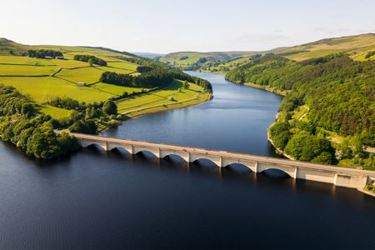England's Water Crisis Needs More Than Just New Reservoirs — Here's What Will Help

By Hannah Cloke, University of Reading
England is facing a water crisis. The UK government has just announced plans to fast-track two massive reservoir projects in Cambridgeshire and Lincolnshire, warning that without them, we could run out of drinking water by the mid-2030s. But as a hydrologist who studies Britain’s often erratic weather patterns, I believe these reservoirs alone won’t solve our water problems.
No major reservoirs have been completed in England since 1992. But the rising population, housing developments and the construction of data centres which use large amounts of water as a coolant are putting intense pressure on our water supplies.
Meanwhile, climate change is bringing hotter, drier summers that increase the risk of drought, as a warmer atmosphere soaks up more water and moves it around in increasingly extreme patterns. This year’s arid spring has already pushed north-west England into official drought status.
The government’s solution is to build nine new reservoirs by 2050, potentially providing 670 million litres of extra water daily. The two fast-tracked projects in Cambridgeshire and Lincolnshire are pencilled for completion in 2036 and 2040 respectively. On paper, this sounds like a sensible response to a growing crisis.
But here’s the problem: we’re thinking about water all wrong. We need a complete overhaul of the way we use water. We need to plug leaks, cut down on waste and use water more than once in our homes and buildings before sloshing it down the drain. We need to catch more water wherever it falls — not just in the river basins that are linked to big reservoirs.
Water companies lose billions of litres daily through leaky pipes. Some estimates suggest that around 20% of treated water never reaches taps because it seeps out of ageing infrastructure. Meanwhile, we’re planning to pump water across huge distances from new reservoirs to supply areas that could be managing their local water resources far more efficiently.
It would be better to make more difficult decisions around the regulation of new buildings, as well as retrofitting older homes and businesses, to cut waste and recycle water where it is used. This isn’t just about taking shorter showers or turning off taps as you brush your teeth — although these things do help.
We need systematic changes: building standards that require water recycling systems, tighter management of water-hungry developments in already dry areas and serious investment in our crumbling water infrastructure.
The reservoirs planned for Cambridgeshire and Lincolnshire will take more than a decade to complete and will cost billions of pounds. In the UK, little research has been done to compare the costs of major infrastructure against a mass roll out of household-level water saving techniques.
Such schemes are rare in Europe. But evidence from historically water-scarce regions, such as parts of Australia, have shown that widely-adopted community and domestic water storage and recycling is cost effective. In the past, the approach in the UK and most European countries has followed a traditional model that often dates to Victorian times, or before.
These civic water supply and drainage systems were built to address public health crises and cut water-borne diseases across urban areas.
But an unprecedented climate calls for unprecedented solutions. These could include the widespread roll out of sustainable drainage solutions that mimic nature and capture rainwater where it falls, on roofs or ditches filled with plants, rather than letting it rush straight down the drains into the rivers.
Britain’s weather has always been variable, but it’s now extremely variable. We’ve experienced this seesaw pattern of drought followed by flooding, as seen in the contrast between dry and wet months seen over the past year.
This all-or-nothing rainfall pattern makes it even more important to capture and store water locally when we have it, rather than relying on large, centralised infrastructure that may be in the wrong place when extreme weather strikes.
The government’s decision to override local planning objections for these reservoir projects highlights another issue. Communities may be asked to sacrifice their land and landscapes for water infrastructure that primarily serves distant urban areas. This approach feels increasingly outdated when we could manage water more sustainably at the local level.
None of this means we don’t need new reservoirs. More water storage needs to be part of the solution. But while big reservoir projects may be politically attractive as they are visible examples of government action, they shouldn’t be our only solution, or even our primary one.
The climate crisis demands that we think differently about water. A warmer world shifts water from region to region more easily, causing problems by its presence or its absence. In the UK, we will increasingly have to treat water as a precious resource, to be more carefully managed wherever we find it.![]()
Hannah Cloke, Professor of Hydrology, University of Reading
This article is republished from The Conversation under a Creative Commons license. Read the original article.
